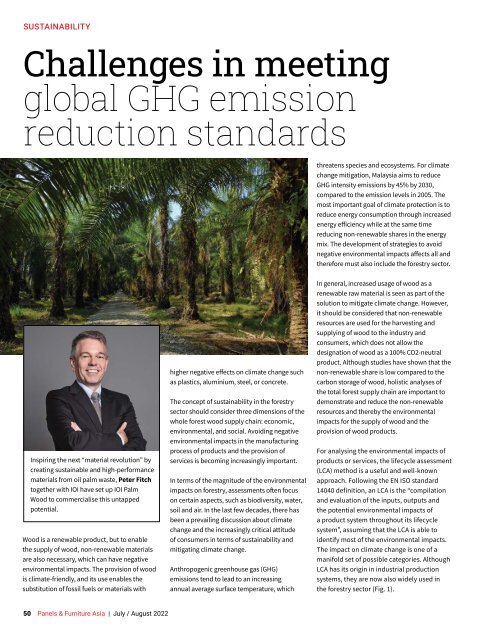Panels & Furniture Asia July/August 2022
Panels & Furniture Asia (PFA) is a leading regional trade magazine dedicated to the woodbased panel, furniture and flooring processing industry. Published bi-monthly since 2000, PFA delivers authentic journalism to cover the latest news, technology, machinery, projects, products and trade events throughout the sector. With a hardcopy and digital readership comprising manufacturers, designers and specifiers, among others, PFA is the platform of choice for connecting brands across the global woodworking landscape.
Panels & Furniture Asia (PFA) is a leading regional trade magazine dedicated to the woodbased panel, furniture and flooring processing industry. Published bi-monthly since 2000, PFA delivers authentic journalism to cover the latest news, technology, machinery, projects, products and trade events throughout the sector. With a hardcopy and digital readership comprising manufacturers, designers and specifiers, among others, PFA is the platform of choice for connecting brands across the global woodworking landscape.
- No tags were found...
Create successful ePaper yourself
Turn your PDF publications into a flip-book with our unique Google optimized e-Paper software.
SUSTAINABILITY<br />
Challenges in meeting<br />
global GHG emission<br />
reduction standards<br />
threatens species and ecosystems. For climate<br />
change mitigation, Malaysia aims to reduce<br />
GHG intensity emissions by 45% by 2030,<br />
compared to the emission levels in 2005. The<br />
most important goal of climate protection is to<br />
reduce energy consumption through increased<br />
energy efficiency while at the same time<br />
reducing non-renewable shares in the energy<br />
mix. The development of strategies to avoid<br />
negative environmental impacts affects all and<br />
therefore must also include the forestry sector.<br />
Inspiring the next “material revolution” by<br />
creating sustainable and high-performance<br />
materials from oil palm waste, Peter Fitch<br />
together with IOI have set up IOI Palm<br />
Wood to commercialise this untapped<br />
potential.<br />
Wood is a renewable product, but to enable<br />
the supply of wood, non-renewable materials<br />
are also necessary, which can have negative<br />
environmental impacts. The provision of wood<br />
is climate-friendly, and its use enables the<br />
substitution of fossil fuels or materials with<br />
higher negative effects on climate change such<br />
as plastics, aluminium, steel, or concrete.<br />
The concept of sustainability in the forestry<br />
sector should consider three dimensions of the<br />
whole forest wood supply chain: economic,<br />
environmental, and social. Avoiding negative<br />
environmental impacts in the manufacturing<br />
process of products and the provision of<br />
services is becoming increasingly important.<br />
In terms of the magnitude of the environmental<br />
impacts on forestry, assessments often focus<br />
on certain aspects, such as biodiversity, water,<br />
soil and air. In the last few decades, there has<br />
been a prevailing discussion about climate<br />
change and the increasingly critical attitude<br />
of consumers in terms of sustainability and<br />
mitigating climate change.<br />
Anthropogenic greenhouse gas (GHG)<br />
emissions tend to lead to an increasing<br />
annual average surface temperature, which<br />
In general, increased usage of wood as a<br />
renewable raw material is seen as part of the<br />
solution to mitigate climate change. However,<br />
it should be considered that non-renewable<br />
resources are used for the harvesting and<br />
supplying of wood to the industry and<br />
consumers, which does not allow the<br />
designation of wood as a 100% CO2-neutral<br />
product. Although studies have shown that the<br />
non-renewable share is low compared to the<br />
carbon storage of wood, holistic analyses of<br />
the total forest supply chain are important to<br />
demonstrate and reduce the non-renewable<br />
resources and thereby the environmental<br />
impacts for the supply of wood and the<br />
provision of wood products.<br />
For analysing the environmental impacts of<br />
products or services, the lifecycle assessment<br />
(LCA) method is a useful and well-known<br />
approach. Following the EN ISO standard<br />
14040 definition, an LCA is the “compilation<br />
and evaluation of the inputs, outputs and<br />
the potential environmental impacts of<br />
a product system throughout its lifecycle<br />
system”, assuming that the LCA is able to<br />
identify most of the environmental impacts.<br />
The impact on climate change is one of a<br />
manifold set of possible categories. Although<br />
LCA has its origin in industrial production<br />
systems, they are now also widely used in<br />
the forestry sector (Fig. 1).<br />
50 <strong>Panels</strong> & <strong>Furniture</strong> <strong>Asia</strong> | <strong>July</strong> / <strong>August</strong> <strong>2022</strong>


















